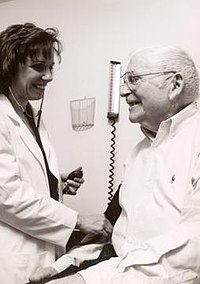
Photo from wikipedia
Background The 2018 MISSION Act sought to improve Veterans’ access to primary care by allowing Veterans living more than 30 min from VA care to utilize non-VA clinics. The impact of… Click to show full abstract
Background The 2018 MISSION Act sought to improve Veterans’ access to primary care by allowing Veterans living more than 30 min from VA care to utilize non-VA clinics. The impact of this legislation may vary for rural compared to urban Veterans. Objective Assess the extent to which the 2018 MISSION Act facilitates spatial access to primary care for Veterans living in rural versus urban Oregon. Design We identified locations of all VA and non-VA primary care clinics in Oregon then calculated 30-min drive-time catchment areas from census tract centroids to the nearest clinics. We compared measures of spatial access to primary care for Veterans in rural, micropolitan, and urban areas. Participants American Community Survey data representing Oregon adults. Main Measures Two measures of spatial access focusing on the number of clinics (supply), and an access index based on the two-step floating catchment area method (2SFCA) which accounts for number of clinics (supply) and population size (demand). Key Results Compared to only 13.0% of rural Veterans, 83.6% of urban Veterans lived within 30 min’ drive time of VA primary care. Given the MISSION Act’s eligibility criteria, 81.6% of rural Veterans and ~ 97% of urban and micropolitan Veterans had spatial access to primary care. When accounting for both supply and demand, rural areas had significantly higher access scores ( p < 0.05) compared to urban areas. Conclusions Using MISSION Act guidelines for Veteran access to primary care, rural compared to urban Veterans had less spatial access based on clinic number (supply), but more access when considering clinic number and population size (supply and demand). Geographic Information System (GIS) spatial techniques may help to assess changes in access to care. However, these methods do not incorporate all dimensions of access and work is needed to understand whether utilization and quality of care is improved.
Journal Title: Journal of General Internal Medicine
Year Published: 2022
Link to full text (if available)
Share on Social Media: Sign Up to like & get
recommendations!